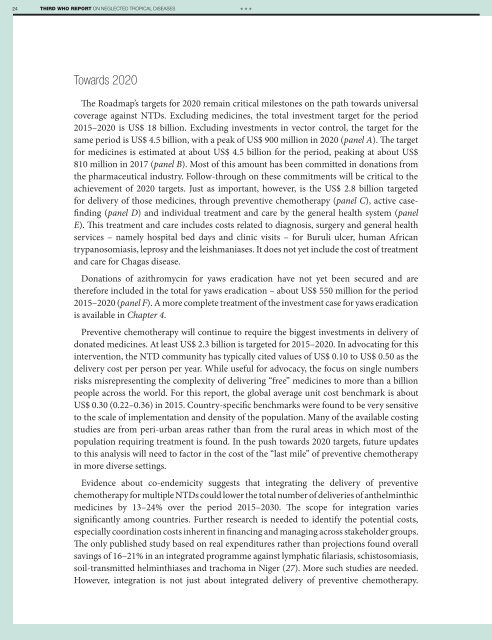1A9bnbK
1A9bnbK
1A9bnbK
Create successful ePaper yourself
Turn your PDF publications into a flip-book with our unique Google optimized e-Paper software.
24 THIRD WHO REPORT ON NEGLECTED TROPICAL DISEASES<br />
***<br />
Towards 2020<br />
The Roadmap’s targets for 2020 remain critical milestones on the path towards universal<br />
coverage against NTDs. Excluding medicines, the total investment target for the period<br />
2015–2020 is US$ 18 billion. Excluding investments in vector control, the target for the<br />
same period is US$ 4.5 billion, with a peak of US$ 900 million in 2020 (panel A). The target<br />
for medicines is estimated at about US$ 4.5 billion for the period, peaking at about US$<br />
810 million in 2017 (panel B). Most of this amount has been committed in donations from<br />
the pharmaceutical industry. Follow-through on these commitments will be critical to the<br />
achievement of 2020 targets. Just as important, however, is the US$ 2.8 billion targeted<br />
for delivery of those medicines, through preventive chemotherapy (panel C), active casefinding<br />
(panel D) and individual treatment and care by the general health system (panel<br />
E). This treatment and care includes costs related to diagnosis, surgery and general health<br />
services – namely hospital bed days and clinic visits – for Buruli ulcer, human African<br />
trypanosomiasis, leprosy and the leishmaniases. It does not yet include the cost of treatment<br />
and care for Chagas disease.<br />
Donations of azithromycin for yaws eradication have not yet been secured and are<br />
therefore included in the total for yaws eradication – about US$ 550 million for the period<br />
2015–2020 (panel F). A more complete treatment of the investment case for yaws eradication<br />
is available in Chapter 4.<br />
Preventive chemotherapy will continue to require the biggest investments in delivery of<br />
donated medicines. At least US$ 2.3 billion is targeted for 2015–2020. In advocating for this<br />
intervention, the NTD community has typically cited values of US$ 0.10 to US$ 0.50 as the<br />
delivery cost per person per year. While useful for advocacy, the focus on single numbers<br />
risks misrepresenting the complexity of delivering “free” medicines to more than a billion<br />
people across the world. For this report, the global average unit cost benchmark is about<br />
US$ 0.30 (0.22–0.36) in 2015. Country-specific benchmarks were found to be very sensitive<br />
to the scale of implementation and density of the population. Many of the available costing<br />
studies are from peri-urban areas rather than from the rural areas in which most of the<br />
population requiring treatment is found. In the push towards 2020 targets, future updates<br />
to this analysis will need to factor in the cost of the “last mile” of preventive chemotherapy<br />
in more diverse settings.<br />
Evidence about co-endemicity suggests that integrating the delivery of preventive<br />
chemotherapy for multiple NTDs could lower the total number of deliveries of anthelminthic<br />
medicines by 13–24% over the period 2015–2030. The scope for integration varies<br />
significantly among countries. Further research is needed to identify the potential costs,<br />
especially coordination costs inherent in financing and managing across stakeholder groups.<br />
The only published study based on real expenditures rather than projections found overall<br />
savings of 16–21% in an integrated programme against lymphatic filariasis, schistosomiasis,<br />
soil-transmitted helminthiases and trachoma in Niger (27). More such studies are needed.<br />
However, integration is not just about integrated delivery of preventive chemotherapy.


